|
Disclaimer: The views and opinions expressed in these articles are those of the authors and do not necessarily reflect the official policy or position of Wrestling-Titles.com or its related websites.
"Pioneers’ Catch-as-catch-can"
by Ruslan C Pashayev
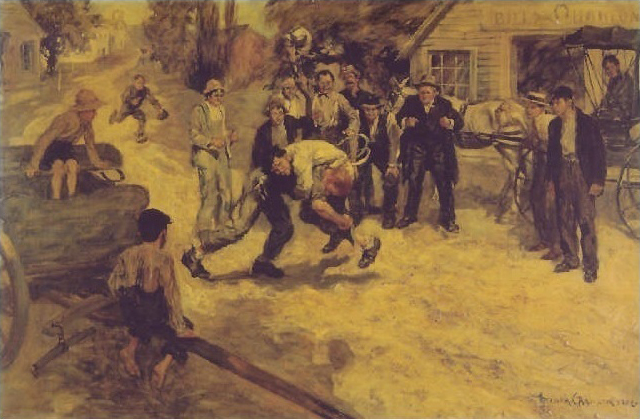 "The Wrestling Match", 1902
"The Wrestling Match", 1902
Artist: Fletcher C. Ransom (United States)Over the last two years I have received many emails from wrestling fans asking me to share what I know about the early American folk catch wrestling, or what many call pioneers’ catch-as-catch-can. Most often I am asked a question about how good of a catch wrestler was the 16th president of the United States Abraham Lincoln (1809-1865). Of course nearly everyone heard a story about how in his younger years he was a great wrestler in popular American traditional styles such as Square Hold (Collar and Elbow), Side Hold, and Back Hold, but not only that, in minds of many wrestling fans in United States Abe Lincoln was also very proficient in catch-as-catch-can wrestling. Interestingly, among the fans President Lincoln is often seen as the absolute master of a certain brand of catch-as-catch-can, the so-called Modern Catch Wrestling which currently is a very popular in America and world-wide pin and submission professional grappling sport.
So I finally decided to address this, but before I will share what I have to say on this subject, I would like to mention something what I count as important to remember and consider prior going into a deeper analyses of this matter. The idea, the concept of the art of wrestling of the American pioneers, and their knowledge of wrestling, and the overall approach was what I would call, very pragmatic and practical. Those people lived their whole entire lives in war-like conditions, and wrestling skill was seen by them as an efficient form of self-defense, applicable in their very dangerous daily existence. Hence their wrestling was designed for one single purpose of being efficient in the fight.
As a matter of fact a free style wrestling variations existed in North American prior the arrival of the Lancashire wrestling professionals who brought with them and popularized in the United States the art of up and down catch-as-catch-can wrestling, a style which was culturally unique to the native residents of the eastern parts of Lancashire County in England. In my book “The Story of Catch” (2019) on Pages 207 and 213 (Part 18, American Style Pro Wrestling) I talk about the Illinois and Ohio variations of traditional North American wrestling style which allowed catching holds of any part of the person’s body. It is obvious that those two localities weren’t the only in United States where they practiced somewhat similar styles of wrestling. Based on the given descriptions of those two examples it is pretty clear that they both were basically the same sport. That kind of wrestling was known under the different names among its practitioners depending on the region. Among the very popular and quite descriptive names of that vigorous pastime was such as “run, catch and throw”, that didn’t mean to stand up and take a hold, but run in, catch by the head or leg or anyway and try to throw your opponent the best you can. Most commonly in the 19 century this type of wrestling was known as catch-as-catch-can. The hotbed of this style was Midwest of the United States.
The pioneers’ perception of wrestling was based on traditional British understanding of what actually game of wrestling is about, which can be summarized as “wrestling is throwing.” Probably the best description of this concept is given in Encyclopedia Britannica (1891) in article “Wrestling and Boxing” (Vol. 24, Page 725): “Wrestling is the art of forcing an antagonist to the ground without resorting to the blows or kicks. It is a trial of strength and skill between two opponents standing face to face, who strive to throw one another.”
In his 1922 book called “Daniel Boone: Wilderness Scout” American writer Stewart Edward White (1873-1946) gives, to my personal taste, the best explanation of what kind of wrestling the pioneers’ catch-as-catch-can actually was. Daniel Boone (1734-1820) the main character of this book was an American pioneer and frontiersman who became famous for his exploration and settlement of what is now Kentucky, his glorious deeds made him one of the first folk heroes of United States. The “catch wrestling” reference appears on Page 10 of the 1926 edition of that book:
“This physical prowess was further encouraged by the sports of the day. They did not have baseball, nor basketball, nor football. But when boys, or grown men, got together they played games just the same. Catch -as-catch can wrestling was much in vogue. There were no complicated rules. You just got hold of the other fellow and tried to throw him. Technicalities did not go. It did you no good to prove that both shoulders were not on the ground; you were flat on your back, and that was enough. It got you nowhere to flop promptly and then play a defensive game flat on your tummy; you were down, and — what was the real point - your opponent could beat your face in or tomahawk you, were it the real thing. You were licked.”
From what this paragraph says it is obvious that the main feature of the pioneers’ catch wrestling was to throw opponent flat onto his back from the standing position, with or ideally without following him to the ground, i.e. retaining your own feet. Basically it was either to throw and remain standing, or to throw and land on top of your adversary. And as the author says this particular skill was very applicable in real life fighting situations.
If you were able to knock-out your opponent in a fight by the violent throw, and thus finish the fight even before it started, or if you are standing and your opponent is helplessly lying at your feet, he is completely at your mercy, and you are the master of him. The advantage of the instant uppermost, mount position which naturally follows the properly executed throw is also obvious; it gives the attacker an advantage of control over the defensive wrestler who is flat underneath him (whether he’s on his back, stomach or side), in case the fight continues on the ground. The basic modern MMA principle which is “ground and pound” was a big part of that philosophy.
It was not a just a sport or pastime for the pioneers but a preparation for the actual real life challenges and dangerous situations such as being suddenly attacked by some strangers. The art itself consisted not in trying to achieve control after you landed, when you are already on the ground, but rather in being in total control from a get go, from the very beginning point of obtaining the hold and until landing on top. Those “falls” weren’t just takedowns, they were actual throws designed to make your opponent land completely flat underneath you. The actual pioneers’ catch-as-catch-can wrestling skill was in ability to take an advantageous hold of your opponent and perform a throw which you can control completely throughout the whole entire process of executing it. And that often was a decisive factor in almost daily fights which formed an essential part of the pioneers’ life.
 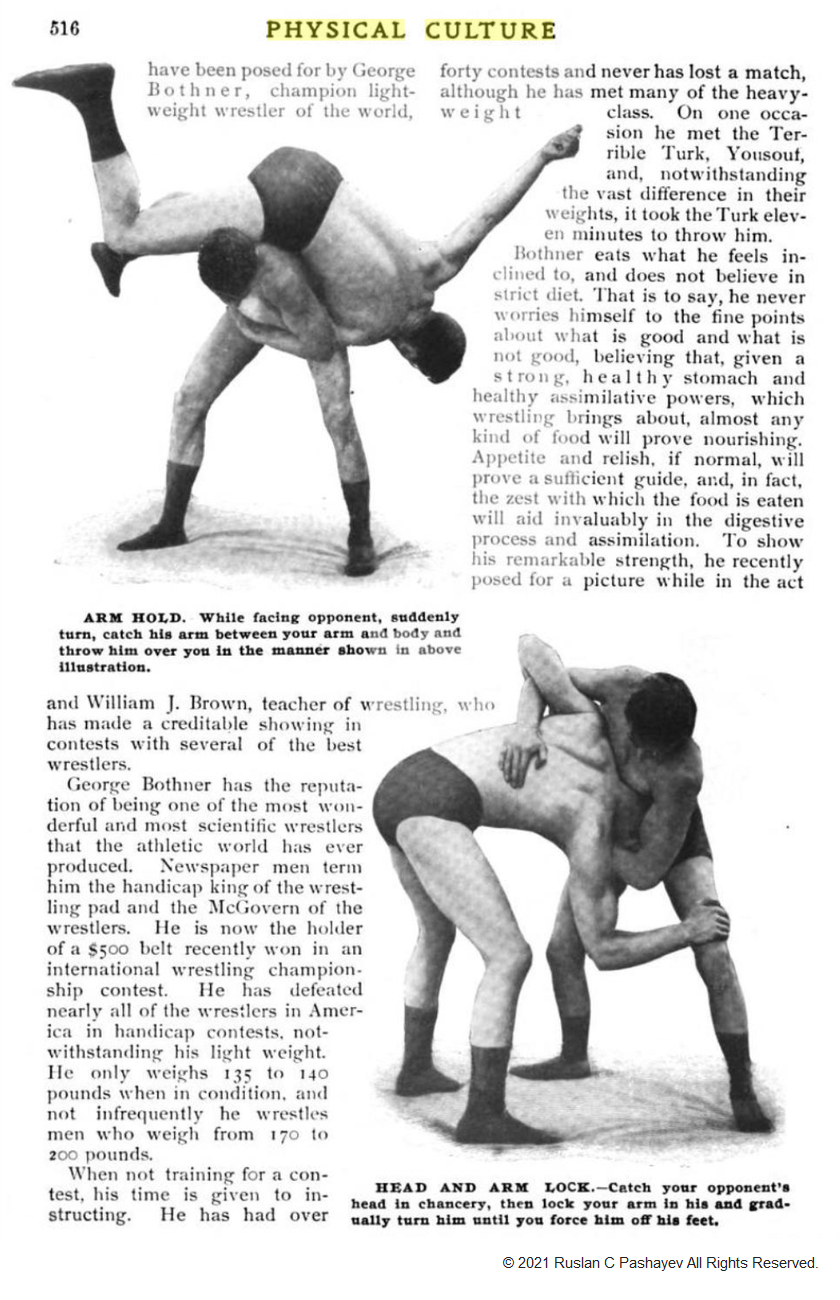 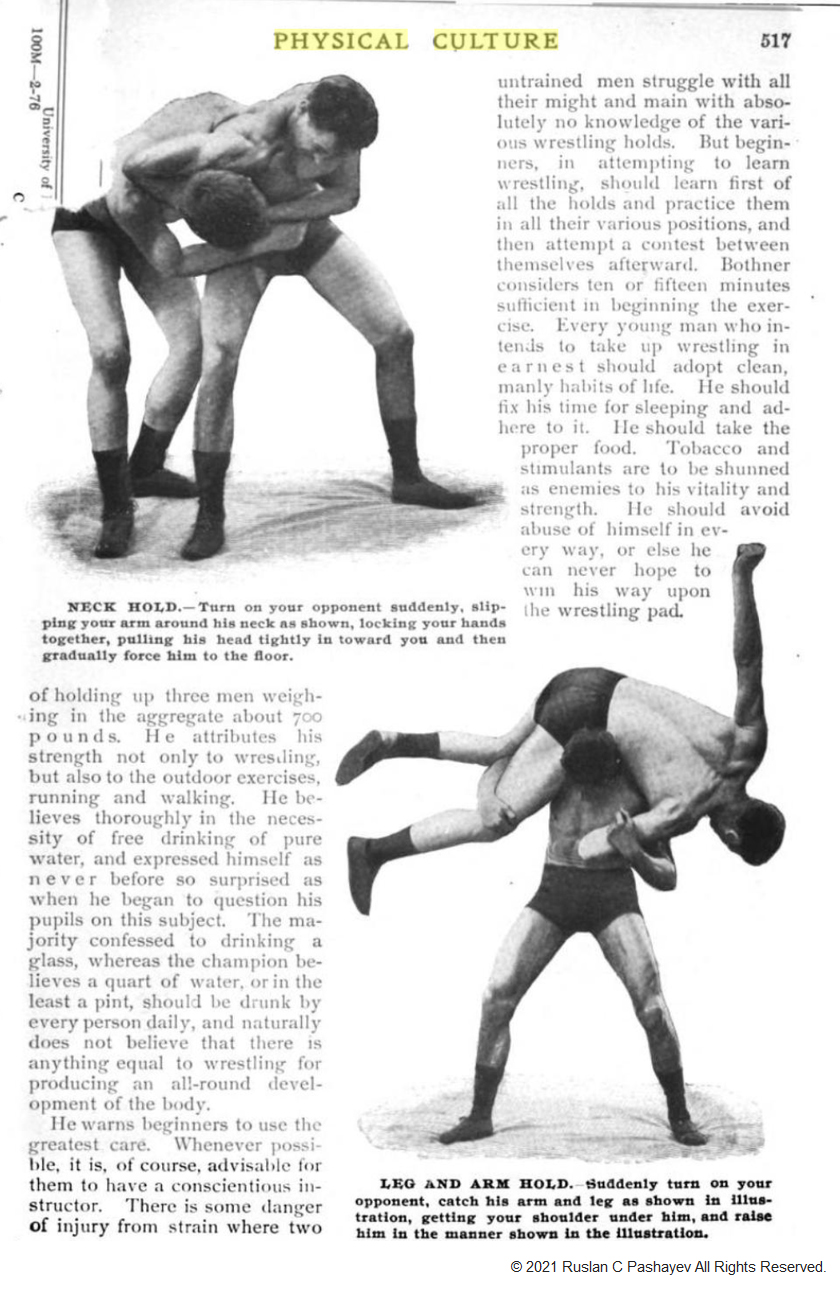 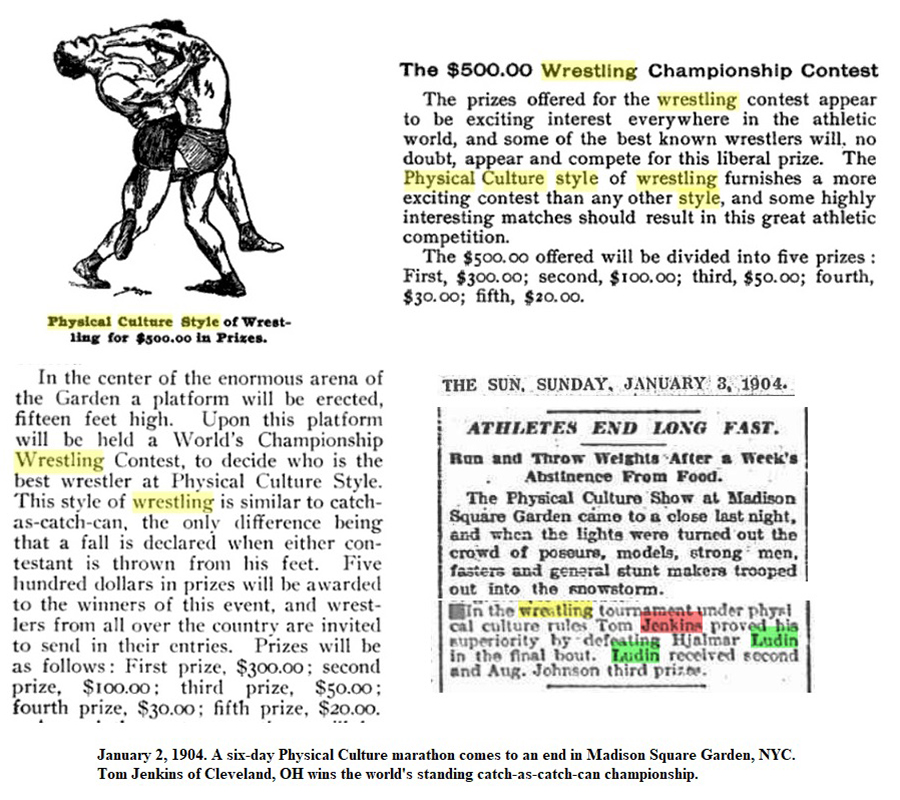 Notably, in the 1910s-20s similar catch-as-catch-can wrestling was still taught and practiced in the American Army. The article called “New Physical and Bayonet Training Course” by Maj. J.C. Drain, Infantry which appeared in Infantry Journal (Vol. XVI, December 1919, No 6) contains information about such variation of catch wrestling, which I would define as standing catch hold of any part of the person’s body in which the objective is to throw an adversary flat on the ground, i.e. flat fall.
This kind of catch-as-catch-can wrestling was covered in the Personal Combat section along with Boxing and Hand-to-hand Fighting. In this manual wrestling and boxing were treated as sports, while all the foul and unsportsmanlike methods were grouped under the heading of hand-to-hand fighting. Catch-as-catch-can Wrestling instructions are on Page 477.
Wrestling.
The next step was to give instruction in catch-as-catch-can wrestling. As a physical exercise, there is no sport which calls for so much strength, endurance and agility, combined with cool judgment, as does wrestling. As soldiers love to oppose their strength to that of others, wrestling will probable prove to be a very popular army sport.
Wrestling as outlined in this course may be considered as an abbreviated form of catch-as-catch-can, with all ground wrestling eliminated and all fouls barred, e. g., strangle holds, hacking, striking, kicking and gouging the opponent. The object in view is not to pin the opponent to the ground, but to throw him. Whenever a man is thrown so that any part of his body, except his hands, feet or knees, touches the ground, he loses the match, or if both men go to the ground, the one on top wins.
The course was planned so that an entire platoon of company could be instructed at one time and the company champion selected inside of thirty minutes of competition.
All technical verbiage was avoided and the subject was presented in a manner which could be grasped easily by the military man. The course consisted of the following:
- Wrestling position.
- Wrestler's grip.
- Referee's hold.
- Frontal attack methods.
- Defense vs. frontal attacks.
- How to get behind opponent.
- To attack from the rear.
- Defense vs. attacks from rear.
- General rules.
- Competition rules.
- Outline of systematized method of handling subject in four 30-minute lessons.
I also would like to add that this generic American pioneers’ catch-as-catch-can shouldn’t be confused with an up and down wrestling (or rough and tumble) wrestling which was very popular among local men since Colonial times as well. In that wrestling pastime which also permitted any form of fair attack the goal was not only in achieving the dominant position (you are on top and your opponent is flat underneath you, most commonly but not exclusively on his back) but by using any fair wrestling methods try to maintain the uppermost position. That was achieved by either “capturing” him, i.e. locking him with a certain hold from which he cannot escape being restricted in his movement, and that instantly makes him unable to reverse his undermost position which leads to an immediate termination of contest; or continue wearing him down for as long as possible until he gives up from exhaustion being unable to reverse his undermost position and admits his defeat verbally; in case of it being a supine position I would call it the long pin fall. Up and down wrestling sure assumed a prolonged struggle on the ground. This kind of wrestling originated in Dutch folk wrestling traditions, and was a very popular pastime in the Dutch American pioneers’ communities.
Neither of the mentioned above wrestling pastimes should be confused with a professional sport (or prize ring) of rough and tumble fighting which basically was just an all-in, absolutely free-for-all fight.
What nowadays is known as “submissions” was something that was unknown in the Western world’s wrestling culture. There was no such thing in Western European and North American tradition as winning a wrestling match on submission. The wrestling matches were either won on actual throws or falls of some kind, or on maintaining the on-top or mount position (pre-historical pinfall). The knowledge of what would qualify as submission holds was limited to the holds of Nelson family (holds which put pressure on the neck of defensive wrestler making him stop any resistance), and very basic chokes like “vice-hold”, or “throttling” when attacker puts both his hands on his opponent’s throat and strangles him thus making him quit. Those holds were an essential part of self-defense instruction all over Western Europe since Middle Ages. The headlocks weren’t seen as any kind of submission holds, but were solely used for throwing opponent down most commonly by “giving him hip” or by “giving him back”. Nelsons were widely utilized in both Greco-roman (French) wrestling and in Lancashire catch-as-catch-can wrestling for one single purpose that of turning opponent onto his both shoulders. And often we see in the 1800s wrestling match reports how the journalist would say something like: “one wrestler applied a half-nelson and foot-hold and made his opponent to succumb”, which simply meant that the defensive wrestler was put in the position from which the only escape without hurting themselves is to roll onto their backs, which is what they did and that obviously meant a defeat in both of the mentioned above wrestling styles.
 The actual submission grappling techniques were first introduced in the Western world by Japanese immigrants during the Meiji Era (1868-1912).
 For centuries in Japan besides the actual wrestling (which is sumo) there also was a tradition of submission wrestling culture also known as jiu-jitsu, the “gentle art” of self-defense. In their vocabulary Japanese martial artists had a great variety of submission holds that a skilled wrestler could apply on different parts of his opponent’s body and be a master of his adversary, make him quit. All currently known submission holds (including armbars, arm and wrist-locks, ankle and foot-locks, knee-bars, toe-holds, all kinds of chokes including the most famous triangle choke) which are practiced all over the world and exist in various submission grappling systems are of Japanese jiu-jitsu origin. When Japanese jiu-jitsu instructors first demonstrated their amazing techniques in Western Europe and North America the first people who started trying to learn, utilize and teach these holds and methods were local policemen. That is why in England in the late 1800s-early 1900s jiu-jitsu was known as “Policemen wrestling”. The first jiu-jitsu championships in Western world were also run by police departments; the gentle art of submissions was a skill that any modern policemen had to be trained in. In the early 1900s in United States the Japanese jiu-jitsu masters would often challenge local catch-as-catch-can wrestlers to the match on mixed conditions, the catch wrestler to win had to pin his opponent and that would be enough, and his adversary had to apply a successful submission hold to become a victor. Those kinds of matches were becoming very popular in North America since 1905. But it still took about ten years of “slow evolution” when American pro wrestlers and promoters finally fully realized that “Japanese tricks” are in fact enriching local pro wrestling and make wrestling matches and the in-ring opposition between the two wrestlers look more elaborate, intricate first of all because of the nature of the Japanese method which exhibited the best and fastest “transition from defense to counter-attack into submit”.
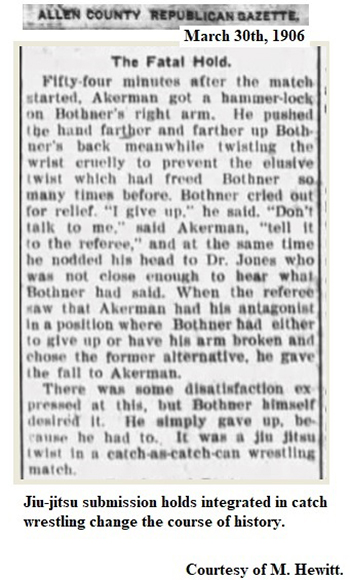 That definitely gained pro wrestling more fans since matches became simply more exciting, more fun to watch. By 1920 many of American pro wrestlers were already exposed to the most of the Japanese jiu-jitsu submission techniques, and they naturally started integrating those holds into catch-as-catch-can wrestling. Initially they introduced into catch only those holds which could lead to a pinfall, since the only way to win a catch wrestling match back then was to achieve a pinfall.
 A unique ruleset, the 1907 “Arizona catch wrestling rules”, which I call “transitional rules”, or rules of the post Japanese jiu-jitsu intro era. It is “new catch” hybrid wrestling in the nutshell. Introduction of 15 minute rounds, long before the 1930s all-in. The victory is a 2 sec pinfall, strangle hold and foot hold are barred unless there’s a chance of turning opponent onto his shoulders. The rules also mention “tapping the mat” a signal to the referee that defensive wrestler isn’t able to continue the contest for various reasons, which also gives the fall to his opponent. As we see these rules aren’t in full and complete compatibility with the nationally accepted Police Gazette Rules.
A unique ruleset, the 1907 “Arizona catch wrestling rules”, which I call “transitional rules”, or rules of the post Japanese jiu-jitsu intro era. It is “new catch” hybrid wrestling in the nutshell. Introduction of 15 minute rounds, long before the 1930s all-in. The victory is a 2 sec pinfall, strangle hold and foot hold are barred unless there’s a chance of turning opponent onto his shoulders. The rules also mention “tapping the mat” a signal to the referee that defensive wrestler isn’t able to continue the contest for various reasons, which also gives the fall to his opponent. As we see these rules aren’t in full and complete compatibility with the nationally accepted Police Gazette Rules.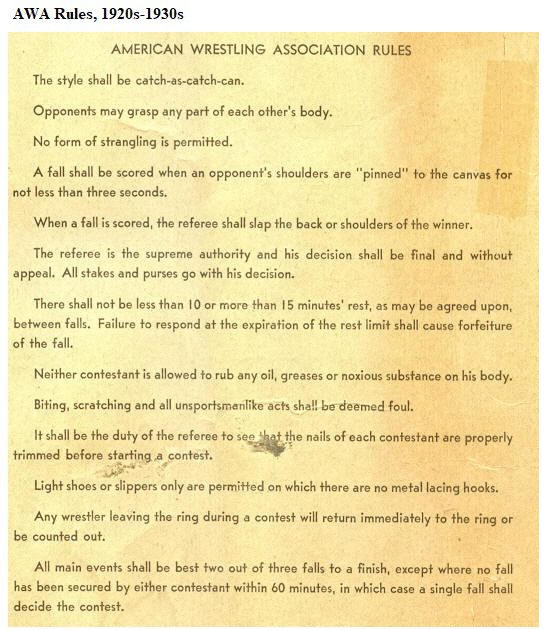 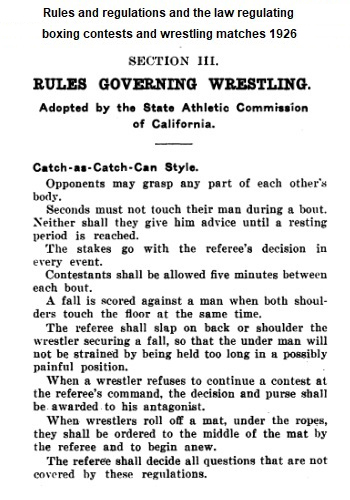 Around 1925 a group of American pro wrestlers headed by famous Austrian wrestler called Henry Irslinger first started running regular pro wrestling matches on hybrid conditions, according to which to win the pro wrestling match you can either pin, submit or knock-out your opponent. Irslinger first tried his system, which he called “all-in wrestling”, in Australia and New Zealand “rasslin ring”, and the fans there loved it, which happened in 1926-28. Then in 1929-30 Irslinger brought his style to Great Britain, where it was explained to the audience that all-in wrestling is an amalgamation of three most efficient wrestling cultures in the world: Western European (French Greco-roman), English (Lancashire catch-as-catch-can) and Japanese (Judo and Jiu-jitsu). In the 1930s all-in wrestling was the only official style of pro wrestling in Great Britain, sometimes different promotions used different names for it (like let’s say some called it “XX Century Catch-as-catch-can”) but essentially it was still the same all-in. The most prominent all-in wrestling promoter in Great Britain during that time period was Sir Atholl Oakeley. The wrestling matches (exhibitions), even though they pleased a great audience of modern wrestling fans, were nothing but the demonstration of various atrocities, brutalities like kicking, punching, tearing ears, noses and mouths, biting, gouging, and other non-wrestling ugly strategies in the ring. The all-in wrestling matches closely resembled the old American rough-and-tumble or gouging matches. The former catch wrestling star from the 1800s Tom Connor of Wigan, Lancs summarized his opinion on all-in wrestling by saying that “there’s no actual wrestling in this kind of wrestling”. As we can tell by its popularity fans liked it anyways, that speaks for the big major switch in tastes and preferences of the crowds.
Among Oakeley’s major business competitors was Geo Relwyskow Sr (former Olympic catch-as-catch-can champion) who was succeeded by his son Relwyskow Jr. who was one of the “chosen people” who owned British pro wrestling for decades. In the 1940s-50s the “new system of pro wrestling” was introduced in the United Kingdom it became known as Mount Evans Style of Wrestling which was still basically all-in with more attention to the wrestling skill and showmanship, and less to the ultra-violence which was the main feature of the original 1930s all-in. This style was “created” and promoted everywhere in Great Britain by Norman Morell the boss of them all in British pro wrestling of that era.
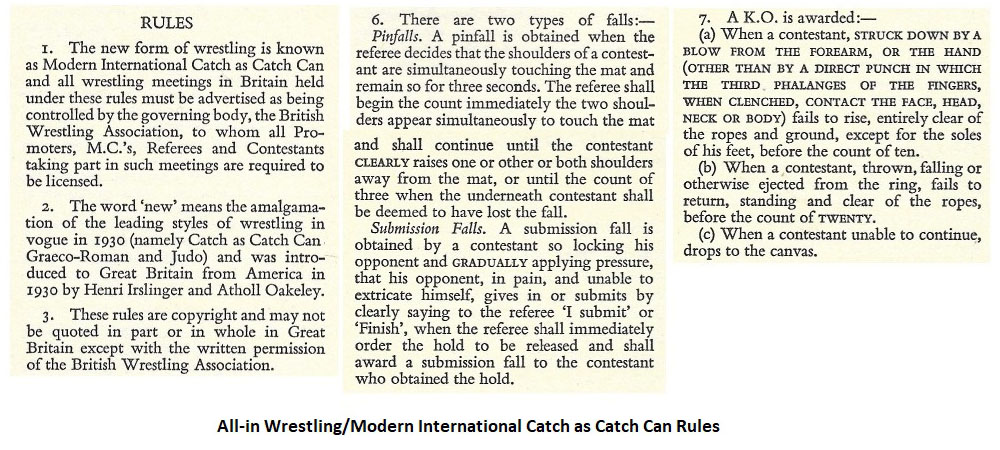 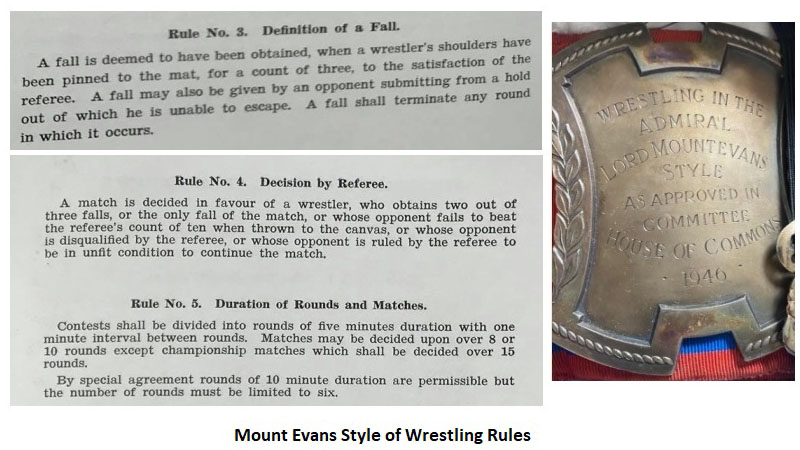 Meanwhile in France, where since the early 1900s Japanese submission jiu-jitsu style became very popular, in 1912 was formed F.F.B.L. (French Federation of Boxing and Wrestling Societies). That organization attempted to control both amateur and professional boxing and wrestling in the country. Being strongly influenced by the new international fashion on hybrid wrestling styles they tried to experiment with French audience by introducing what they called the professional freestyle wrestling. Prior to that local public was familiar only with pro Greco-roman wrestling. The new style was known under the different names such as Lutte Libre (Freestyle) and later Catch-as-catch-can Lutte de Combat, (literally wrestling fight). According to the rules the victory in this new hybrid wrestling sport was possible to achieve either by a 3 sec pinfall, on points, on disqualification or by “abandonment” a term which stood for “refuse to continue match” (tapping the mat 3 times, or verbally notifying the referee) due to various reasons such as exhaustion, injury, or application of legitimate painful/punishment hold (submission hold), etc. Despite running nationals in 1912, and even the world catch-as-catch-can lutte de combat championship in July 1913 (the victor was Constant Le Marin, at the same time in America world catch wrestling champion according the National Police Gazette Rules was still Frank A. Gotch), the F.F.B.L. and its “wrestling only” successor F.F.L. (French Wrestling Federation) failed to succeed with their “catch” affair. The wrestling matches which usually started like proper, normal wrestling would quickly degenerate into a chaotic street brawl and that French people didn’t enjoy at all, and wouldn’t tolerate, in addition to that in 1914 it was nation-wide exposed that all the matches were fixed which basically buried the Lutte Libre hopes in France. After the WW1 the country was back to its beloved pro Greco-roman style. The 1912 French pro freestyle rules were brought back into existence in France in the 1930s, when whole Europe experienced the “new catch”/all-in wrestling boom.
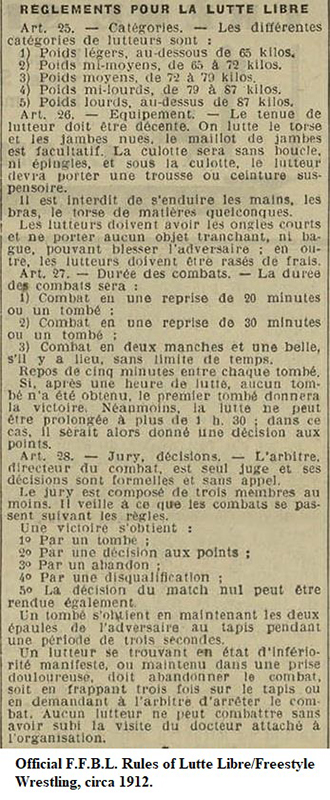 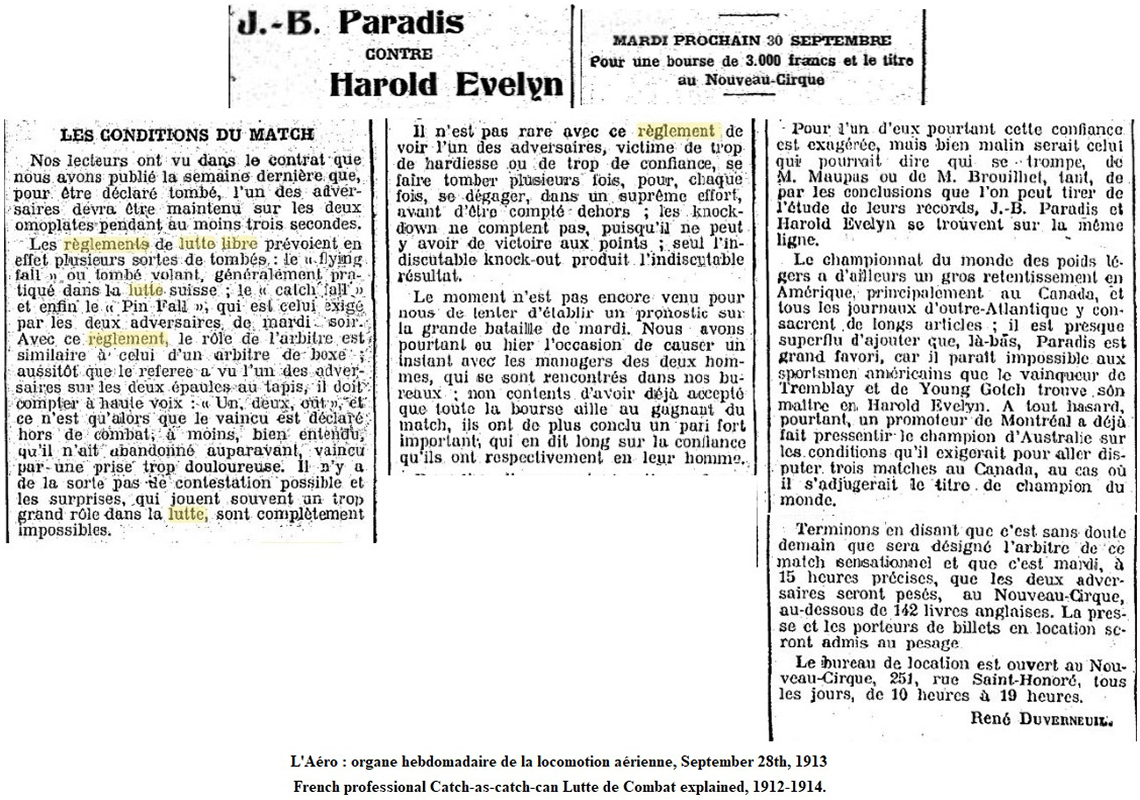 Notably, in the 1910s various catch wrestling manuals issued in North America already featured a lot of holds which they called “punishing holds”, meaning that these holds don’t necessarily lead to a back fall but are designed to torture opponent and thus making him quit. That fact speaks for itself, around that time the knowledge of Japanese jiu-jitsu techniques was already integrated into catch wrestling and became one of its essentials. And even the most famous Wigan's hold, the GROVIT, without any doubts originates from the Japanese jiu-jitsu, and its un-English sounding name is nothing but a tribute the local "shooters" paid to the 19c French (read Greco-Roman) pro wrestlers habit of being way too elegant and wearing CRAVAT (read a tie) on every "wrestling" occasion, just saying. Ironically, the Normans, the French barons who conquered England, brought with them the fashion of wrestling in "collars" to England even back in the Middle Ages, and such professional neckties were well known strangulation tools.
In the United States the “pin, submission, knock-out” hybrid wrestling system was widely introduced in the 1930s. And it happened around this time that the pro wrestling promoters and State athletic commissions officials stopped calling pro wrestling matches catch-as-catch-can simply because it was not catch wrestling anymore, but was an absolutely new historically unrelated, a “hybrid style” of pro wrestling which since then was simply referred to as “pro-wrestling”. The name of catch-as-catch-can was still as it was before internationally used for what now is known as freestyle wrestling.
Ruslan C Pashayev is an expert-member of the Traditional Sports Team of the Instytut Rozwoju
Sportu i Edukacji
(the Institute of Sport Development and Education), Warsaw, Poland.
© 2021 Ruslan C Pashayev All Rights Reserved.
|
